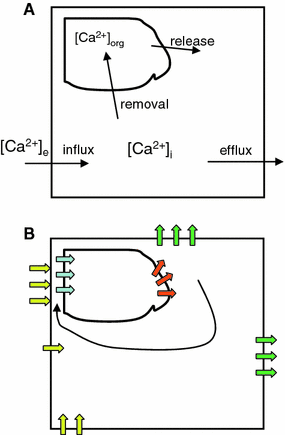The cell boundary theorem: a simple law of the control of cytosolic calcium concentration
- PMID: 19937486
- PMCID: PMC2821834
- DOI: 10.1007/s12576-009-0069-z
The cell boundary theorem: a simple law of the control of cytosolic calcium concentration
Abstract
Many molecular biological interventions in current use, as well as inheritable disease conditions, modify the intracellular endowment of molecules that bind Ca(2+) or channels and pumps that transfer it to and from intracellular storage organelles. A simple law, named the "cell boundary theorem," states that intracellular alterations cannot directly result in changes in the cytosolic concentration, [Ca(2+)](i), in a true resting state. A demonstration of the validity of this theorem is provided. Several examples are then discussed of interventions or diseases that increase leak of Ca(2+) from storage organelles and result in greater resting [Ca(2+)](i). According to the theorem, the increase in [Ca(2+)](i) cannot be a direct consequence of the greater leak. Its primary cause must be a change of the fluxes at the level of the plasmalemma, caused in turn by the increase in leak through some sort of "store-operated Ca(2+) entry." While the law is discussed in terms of Ca(2+) homeostasis, it applies to any solute that may be transported by the plasma membrane.
Figures
Comment in
-
The cell boundary theorem: a simple law of the control of cytosolic calcium concentration.J Physiol Sci. 2013 Mar;63(2):159. doi: 10.1007/s12576-012-0246-3. Epub 2012 Dec 22. J Physiol Sci. 2013. PMID: 23263921 Free PMC article. No abstract available.
References
-
- López JR, Alamo LA, Jones DE, Papp L, Allen PD, Gergely J, Sréter FA. [Ca2+]i in muscles of malignant hyperthermia susceptible pigs determined in vivo with Ca2+-selective microelectrodes. Muscle Nerve. 1986;9:85–86. - PubMed
Publication types
MeSH terms
Substances
Grants and funding
LinkOut - more resources
Full Text Sources
Miscellaneous


